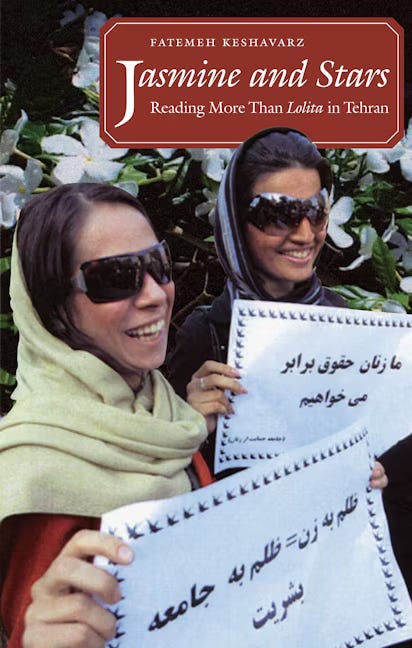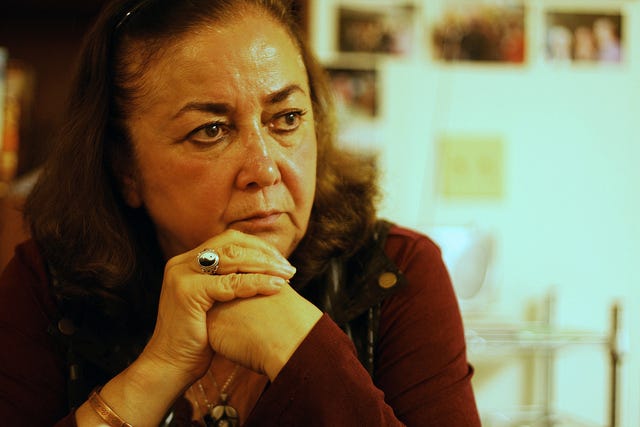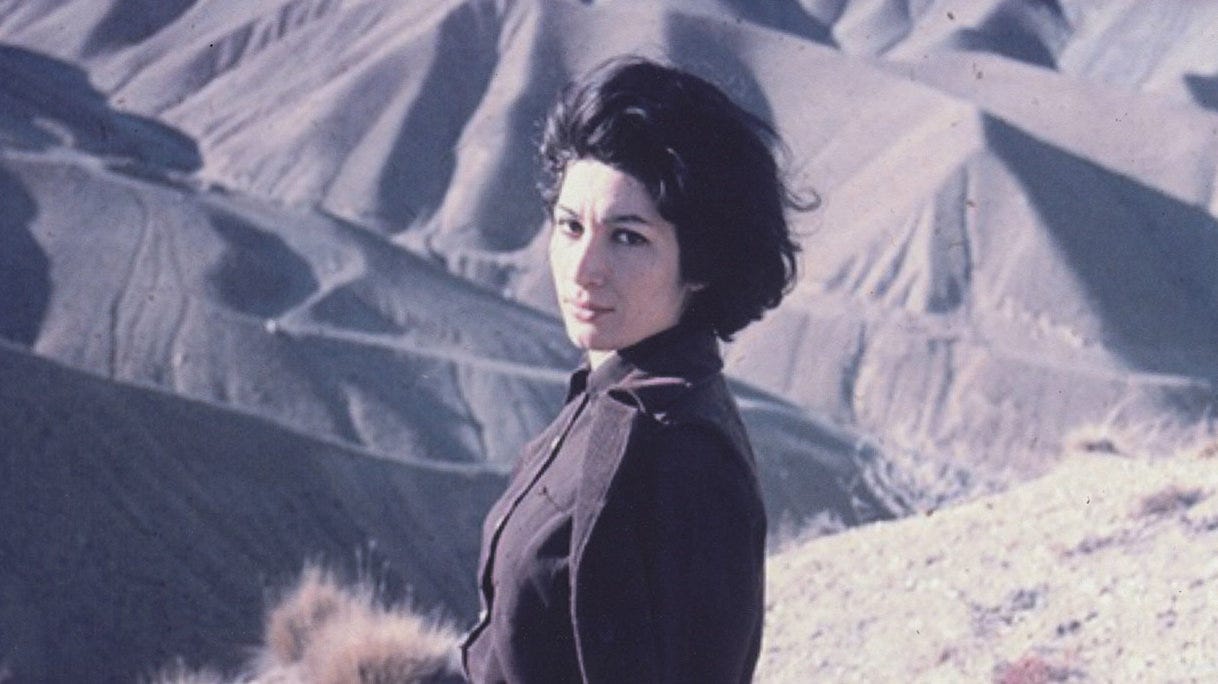Regarding Jasmine and Stars: Reading more than Lolita in Tehran, I should have read this book years ago; it’s been sitting on my shelf for at least six years. In fact, I should have read this book as soon as I saw the Stephen Kinzer blurb on the back. It’s a book about literature, it’s a book about poetry, it’s a book about life, it’s a book about geopolitics, it’s a book about gender relations, it’s a book about a particular place (Iran), and it’s a book—surprisingly enough—about Scripture. Dr Fātemeh Keshāvarz has a remarkable gift for anecdote; and it’s her warm, personal voice that elevates this book from merely ‘good’ to remarkable and sublime.
It is not, I hasten to add, easy. It is in fact quite a challenging text. While you are reading it, you can get the distinct impression that you are reading three books at once. That impression is not, on its face, wrong. Jasmine and Stars is all three: a devastating and trenchant critique of a particular book (Reading Lolita in Tehran by Azar Nafisi, which she refers to by its acronym of RLT); a literary survey of modern Iranian cultural output, with a studied emphasis on female poets and novelists; and a touching personal memoir of the author and her family in Iran.
It isn’t a book without faults. Fātemeh Keshāvarz tends to take considerable liberties with allegory, and then strains those allegories nearly to the breaking point. The images conjured by the title are a case in point; she comes back to those with considerable regularity. She also relates an anecdote from her childhood about being frightened by grasshoppers (which are actually an agrarian pest of considerable damaging potential in rural Iran), which she then uses and overuses in reference to Iran’s problems with religious excess and abuse, both in the personal and in the political sphere.
However, Jasmine and Stars does with aplomb what any worthwhile literary survey ought to do: whet your appetite to read more. The author’s recommendations of contemporary Iranian feminist poets like Forough Farrokhzād and novelists like Shahrnūsh Pārsīpūr are vindication enough for this book’s existence. And it’s clear that Keshāvarz herself is in good company with these two! She is spurred to write by many of the same desires for improvement and justice in her own country that animated them; and her love of her people and place, despite its occasional grasshopper problems, carries through loud and clear in her prose. Her descriptions of Parsipur’s physical appearance and character, in particular her gentle humour, her sense of fair play, her vivid imagination—easily reflect what we can tell of Keshāvarz herself in the way she writes.
From a political perspective, Keshāvarz’s work is also more than serviceable. Her critique of RLT—that it presents a partial, distorted, extreme and unfeeling view of Iran’s society, its women and their problems—is clearly and painstakingly set forth, and it rings resoundingly with a scathing truth. But it is not merely a critique of a single book; it also serves as the ‘sketch’ of a critique of an entire ethos in contemporary English-language literature: ‘New Orientalism’. Yet speaking in the wake of 2023 and the genocide in Palestine, it has become difficult to call such Orientalism ‘New’ anymore. We have seen the results, with our own eyes on TikTok, what results from the distorted view of West Asian affairs which is presented by the ‘New Orientalist’ authors. It turns out: the detestation of Islam and its believers, even as promoted by native informants, is as tacky, as tawdry, as dirty, as flimsy and as criminally false as the ‘Old Orientalism’ it supposedly replaced.
That is not to say that Keshāvarz is a régime apologist—she isn’t. Being a connoisseuse of Western as well as native Iranian literature, I’m sure Keshāvarz would not be offended if I compare her attitude to the Iranian Revolution, to that of Dickens toward the French. She understands that revolutions do not spring from nowhere; where there is no real injustice that goes too long unaddressed, revolutions do not occur. Yet, again, she does not make excuses for or give aid and comfort to the ideologues. She has no patience for fundamentalism—this is something that comes off clearest when she speaks about her uncle’s attitude toward a dead Baha’i relative. Yet she is careful to distinguish genuine Islām, genuine devotion to and love for God, from the ideological counterfeit that goes about in its name. She speaks of what is human about her country, about what is worth sharing.
That brings me to the last chapter of her book, which in some ways is the most frustrating. It’s inconsistently-pitched; it has odd space-breaks. It combines all three ‘books’ into one in what appears at first to be a haphazard way. It is not easy to read through at once. In fact, I was tempted for a moment to downgrade my rating of the book on account of the conclusion, which I thought was a bit of a hot mess. But after sitting with it, pondering it, and going back to reread it a second time, I decided that it was simply brilliant. Allow me to explain.
The anecdotal part of it concerns Keshāvarz’s relationship with her father, which is a bit rockier than her relationship with her sweet, patient, ‘saintly’ uncle. Her father is touchy, opinionated, perfectionist, and sometimes more than a bit critical. Yet she says that she enjoys most her discussions with him about literature. The centrepiece discussion involves a particular couplet from one ġazal by the Sufi poet Ḥāfiẓ:
Love will come to your rescue if like Ḥāfiẓ
You can recite the Qur’ān from memory, in all fourteen versions
Keshāvarz recounts that, although she was a defender of Ḥāfiẓ’s honour against her father’s opinionated preference for Sa‘dī, she was troubled by these two lines. She felt them ‘mediocre’, crude, almost unworthy of Ḥāfiẓ’s genius—to the point where she felt they must have been incorrectly attributed to him. But an incident when her father rescued a pair of kittens from the bottom of a dry well, caused her to suddenly read that verse in a different light. She reinterpreted the verse:
Love [in the end] will come to your rescue [even] if like Ḥāfiẓ
You can recite the Qur’ān from memory, in all fourteen versions
It’s worth noting that even though Persian is an Indo-European language, not a Semitic one, it nevertheless uses an ’ajami writing system borrowed from Arabic. Readers of poetry in the Persian language are, similarly to readers of the Qur’ān in Arabic, are forced to rely on the consonantal text of what the poet writes. A significant degree of the beauty of Persian literature, like the other languages which use abjadic or abjad-influenced writing systems, lies in the wealth of interpretive flexibility which one can bring to it simply by vocalising it differently. Keshāvarz says she applies a ‘change of intonation’ to Ḥāfiẓ’s couplet to bring out this alternate reading. On the other hand, just like a reader of the Qur’ān (or any other work of Arabic literature), one is forced to study the text and understand it before one begins to read it!
And this is actually the genius of how Keshāvarz interprets the couplet. Love has to come before (that is, above in the text) the recitation—that is to say, you have to study before you can read. And ultimately it is love that saves the reading! This is one of the reasons why, in our Orthodox Divine Liturgy, the priest dismisses the reader by saying ‘peace be to you, who has read’. You have studied, you have done the work, you have vocalised the text and lifted up your interpretation before God—now go and rest; be assured that God has heard you.
Keshāvarz’s point here is subtle, and it’s actually quite profound. In order to study something effectively, you have to love it. The couplet by Ḥāfiẓ has the same consonants whichever way you read it. But you can read it in a mediocre and crude way, or you can read it in a sublime way. The same thing goes with the study of a country like Iran—even though Iran is, in fact, a country and not a text! Still, if your study is cursory and your heart isn’t in it, you will only see the grasshoppers. Keshāvarz is giving us a reading of Iran that allows us to smell the jasmine and gaze at the stars as well.











